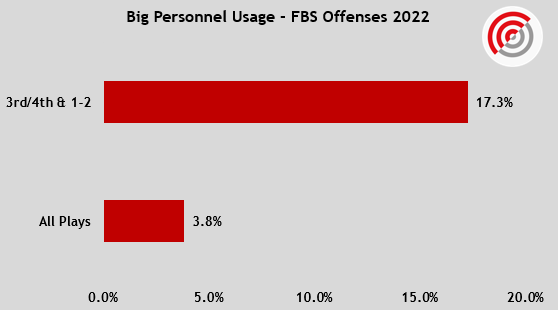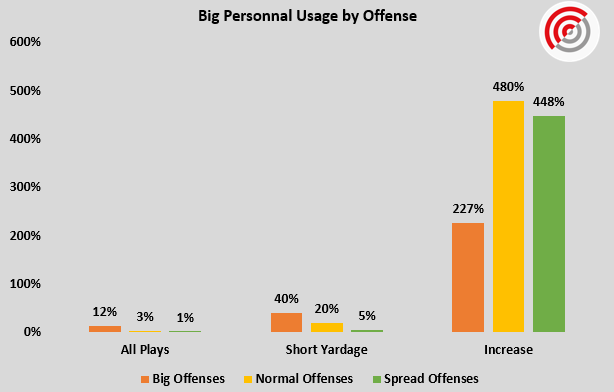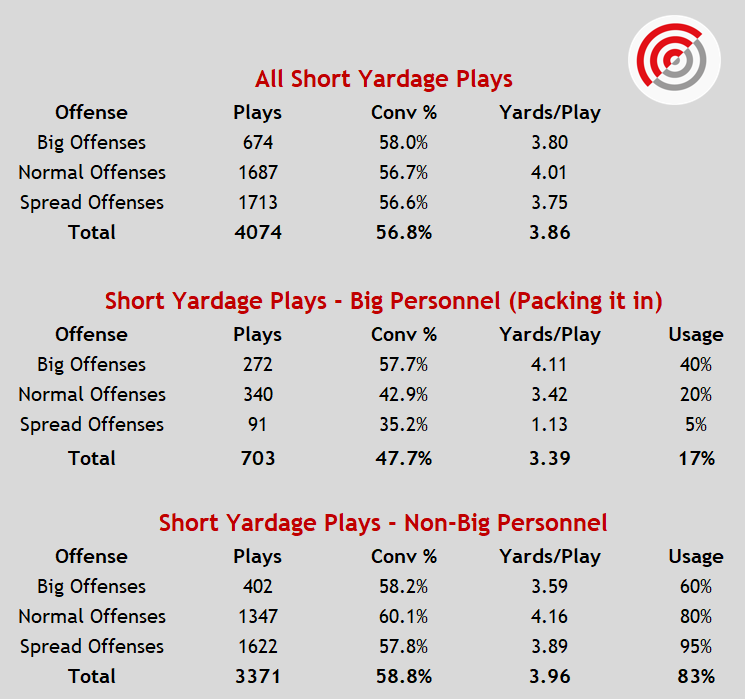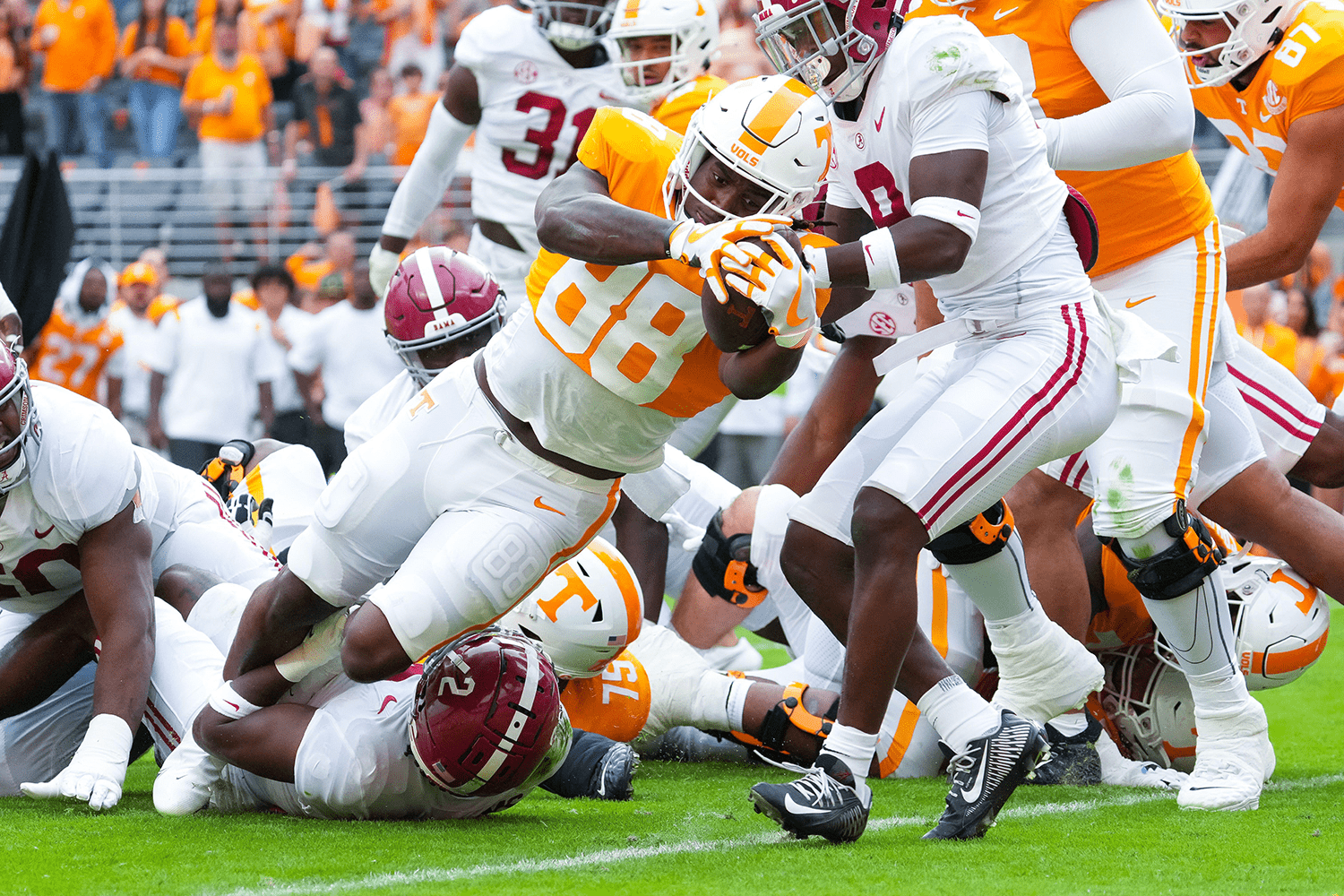Short yardage situations are among the most exciting plays in football. Defined for this analysis as any 3rd or 4th down play with less than 2 yards to go, these plays offer intrigue for a number of reasons.
Across FBS, offenses generally convert between 70-75% on 3rd or 4th-and-1 and between 55-60% on 3rd or 4th-and-2 attempts. While this means the offense earns a new set of downs more often than not, the defense can swing a game by winning a single play. Given those stakes, defenses are often far more aggressive than normal as the benefit of stopping a drive gives good reason to be less cautious in protecting against a big play due to a better ratio of rewards to risks.
A key concept that even a casual observer would be able to pick up on is offenses often utilize bigger personnel packages in these short yardage situations. They’re most often only seeking to gain a yard or two on the play, so even if they know the defense will respond by aggressively crowding the front in their own right, the offense will still “pack it in” in these spots.
According to StatsBomb data, in 2022 FBS offenses utilized “big” personnel packages (any personnel grouping with less than 2 WRs on the field) on just 3.8% of all plays last season. However, this figure jumps to 17.3% in short yardage situations, a mammoth 350% increase from all plays.

“Packing it in” or “going big” has been the way to go in short yardage situations seemingly since the very early days of football. But should that be the case? Is packing it in the most effective way to convert short yardage situations? Does it make sense for teams that rarely utilize bigger personnel groupings to shift to bigger personnel groups for short yardage situations? Do teams that go big on a regular basis have more success in short yardage situations than more spread-based teams?
StatsBomb data can help answer these questions and more.
All Offenses feel the Inclination to Pack it in
FBS offenses are not created equal in terms of big personnel usage. A key aspect of analyzing the shift to such groupings in short yardage situations is determining how often teams utilize these packages in non-short yardage situations.
To control for this, the 131 FBS offenses were divided into three distinct buckets:
- Big Offenses: Teams which use big personnel at least somewhat frequently outside of short yardage situations. The 23 units making up this bucket used big personnel groupings on at least 6% of their total plays. Though these 23 offenses only represent 18% of FBS teams, they are responsible for 52% of all plays featuring big personnel.
- Normal Offenses: Offenses using big personnel packages on between 2% and 6% of their plays. This group is sandwiched around the FBS average of 3.8% big personnel usage. A total of 53 FBS offenses fall into this bucket, making up 38% of all big personnel plays from last season.
- Spread Offenses: Offenses using big personnel groupings on less than 2% of plays. The remaining 55 FBS offenses land in this bucket, with those 42% of teams making up only 10% of total plays in big personnel groupings across FBS last season.
Having categorized the propensity of each offense to line up in big packages, the chart below illustrates that regardless of offensive style, short yardage leads to much more frequent use of big personnel:

“Big” offenses “pack it in” much more often than “Normal” or “Spread” offenses in short yardage situations, but they already do so more frequently in normal down and distance situations. By comparison, “Normal” and “Spread” offenses rarely deploy big personnel outside of short yardage,illustrating the inclination of most coaches to pack it in for short yardage situations. The question is, does it work to do so?
Teams Should Aim For More
Interestingly, overall performance in short yardage situations is largely consistent across the three buckets of offense. Big offenses converted 58% of the time while normal and spread offenses managed to do so on just under 57% of opportunities. Similarly, yards per play were also steady across the three groups. This suggests that teams which play big frequently don’t have quite the advantage in converting short yardage situations as is commonly believed.

There is one central takeaway from above. Big offenses are significantly better at converting short yardage situations from big personnel packages than are teams that rarely enter big packages at other points in the game. “Big” teams had no meaningful change in short yardage performance when going big in short yardage situations, converting slightly less often, but gaining somewhat more yardage on average in big personnel than in other groupings.
The same cannot be said for our “Normal” or “Spread” offenses.Teams which did not frequent big personnel groupings overall saw a large falloff in short yardage performance when trying to go big. Normal offenses only converted 43% of short yardage attempts when packing it in last season, a huge dropoff from their conversion rate of 60% in other groupings.
Likewise, “Spread” offenses were not very effective at converting short yardage situations on the rare (91 times total over the whole season) occasions they attempted to do so from an unfamiliar personnel grouping. Spread teams converted 57% of the time in non-big personnel as compared to just 35% when playing big.
In addition to higher conversion rates, “Normal” and “Spread” offenses gain much more yardage staying true to form rather than going big in short yardage. By contrast, teams which play big have better yardage outcomes when they stay big, which suggests that while short yardage situations may call on a different section of the playbook, teams are usually better off staying true to their offensive identity in short yardage situations.
Mike Bursik
AMF Product Lead
@MikeBursik
